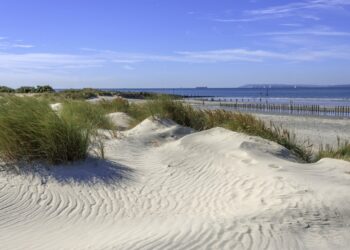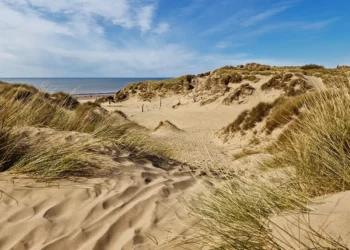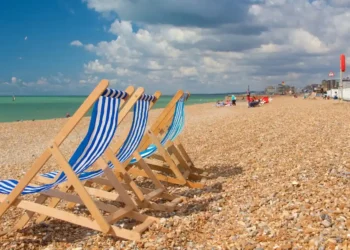Margate Beach sits along the north coast of Kent, England, within the seaside town of Margate in the Thanet district. Widely known for its wide stretch of golden sand, bustling promenade, and blend of old and new attractions, it remains one of the most loved beaches in the region. The beach, about 200 meters long, combines the classic feel of a British seaside with the energy of Margate’s growing arts scene. Managed by Thanet District Council, it has earned the Seaside Award for its clean environment and good facilities. Families, casual visitors, and art lovers all find something appealing here. It is located roughly 76 miles from London, and it is easy to reach for a short trip or weekend getaway.
Interesting Fact About Margate Beach
Just a few minutes from Margate Beach lies the Shell Grotto which is an underground tunnel that has puzzled historians for centuries. Found in 1835, its walls are covered with around 4.6 million seashells forming beautiful and detailed patterns. No one really knows who built it or why and it may date back to the 1700s or even earlier.
History of Margate Beach
Margate’s story as a seaside getaway began around the 1700s, when it slowly changed from a quiet fishing village into a popular retreat. Back then, it was called Meregate, meaning “gateway to the sea.” During the mid-18th century, sea bathing became fashionable after Dr. Richard Russell promoted it for health benefits. By the 1760s, Londoners, especially the wealthy class, started visiting Margate for its clean air and seaside waters. Bathing machines were placed along the beach to let people enter the sea while keeping modesty intact.
During the 1800s, Margate went through what many call its best years. When steamboats started running in 1815 and the railway arrived in 1863, people from London and other areas could reach the seaside easily. Visitors from all sorts of backgrounds began coming, turning the small coastal town into one of England’s busiest holiday spots. Around this time, many landmarks were built, Margate Pier (completed in 1855 and later renamed the Harbour Arm) became a key attraction, and the Winter Gardens, which opened in 1911, hosted dances and local shows. The beachfront soon filled with hotels, theatres, and funfair rides. Dreamland amusement park, which opened in 1920, became one of the town’s most loved symbols of entertainment and joy.
However after the mid-1900s, things started to go downhill. As overseas travel became cheaper, many people began spending their holidays abroad instead of at English seaside towns leading to a steady fall in visitors, and by the 1980s, several old attractions had closed, leaving parts of the town worn and forgotten.
In the early 2000s, though, Margate started to rise again. The Turner Contemporary gallery opened in 2011, named after the painter J.M.W. Turner, who used to often paint the Margate’s skies. Its opening brought fresh attention to the town and inspired many artists and small shop owners to come back.
Things to Do at Margate Beach
Margate Beach has something for everyone, bringing together the charm of a classic seaside day and the creative spirit the town is now known for. You can unwind, explore, or simply enjoy the lively air along the coast.
Beach Fun: The broad sandy shore is great for sunbathing, making sandcastles, or paddling when the water is calm. In summer, lifeguards are on duty, which makes it a safe place for families with children. When the tide moves out, little pools appear among the rocks — perfect for kids to find crabs and seashells.
Dreamland Amusement Park: Just beside the beach stands Dreamland, one of Margate’s best-loved landmarks. It’s full of old-fashioned rides and modern attractions, including the historic Scenic Railway — the oldest roller coaster in Britain. It has a mix of old and new rides, including the Scenic Railway — Britain’s oldest roller coaster that first opened in 1920. The park also hosts live shows, music events, and festivals through the year. You can walk in for free and pay for rides or get a wristband if you want to try more things.
Turner Contemporary: Just a short walk from the beach, this gallery shows modern art and pieces inspired by J.M.W. Turner, who loved Margate’s skies. It doesn’t cost anything to enter, and sometimes they run simple workshops where families or visitors can try out painting or crafts.
Harbour Arm: What used to be an old stone pier is now a lively spot for a stroll. There are mini cafes, bars and small galleries overlooking the sea. You can try here some fresh seafood or just sit and watch the sunset in peace.
Old Town Margate: Behind the beach with its narrow streets and older buildings is the Old Town. You can look through vintage shops, small galleries, and cosy cafes. The Margate Museum shows the town’s history, and the Crab Museum is a fun, quirky stop.
Water Sports: If you enjoy a bit of adventure, you can try paddleboarding, kayaking, or windsurfing. Local spots like Margate Surf School rent out equipment and give lessons so beginners can join without any trouble and the constant coastal breeze makes it a good place for these activities.
Festivals and Events: Margate hosts events all through the year. Margate Pride happens in August with parades and music, while the Margate Bookie in October attracts writers and readers. In summer, Dreamland hosts outdoor concerts and shows.
All these activities artistically mix beach fun with culture and creativity, making Margate Beach feel both traditional and lively at the same time.










